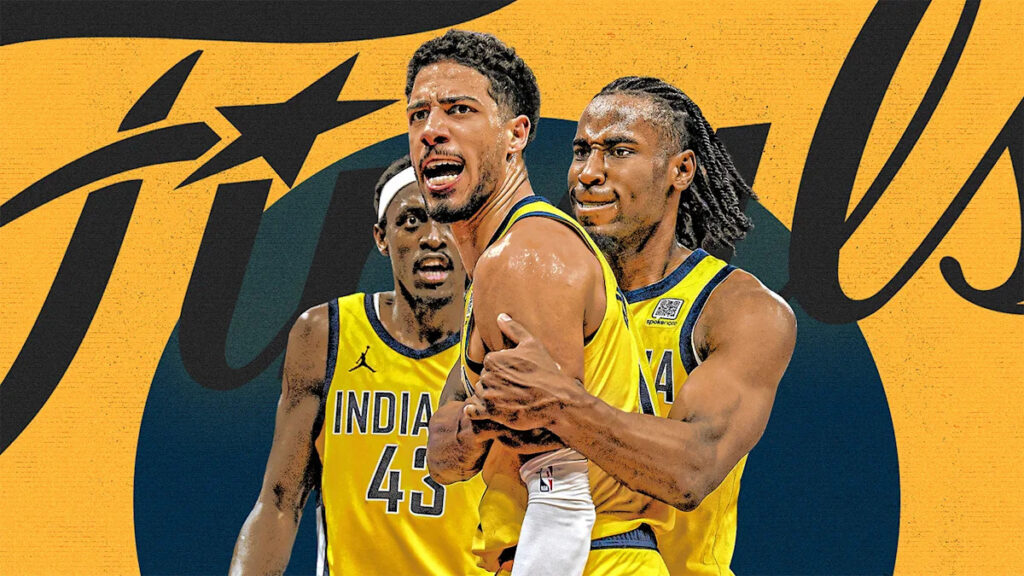As the Indiana Pacers and Oklahoma City Thunder prepare to face each other in the NBA Finals, it’s worth a moment to look back at how they each got there, through the lens of their respective roster construction.
First off, let’s take a look at the Pacers, who used a more traditional approach to get where they are.
Advertisement
Indiana applied a model that’s becoming increasingly popular among NBA teams, which entails having two max-level contracts and considerable depth on the bench.
(Grant Thomas/Yahoo Sports illustration)
The Tyrese Haliburton trade
What’s interesting is how neither Tyrese Haliburton nor Pascal Siakam were drafted by the Pacers, meaning both were external acquisitions — from the Sacramento Kings and Toronto Raptors, respectively.
Indiana shipped All-Star center Domantas Sabonis to the Kings in a deal for Haliburton, who at the time was available due to the presence of De’Aaron Fox.
(Side note: Why is Sacramento afraid of having multiple ball-handlers? This is the same team that allegedly had issues with the idea of drafting Luka Dončić in 2018, also due to the presence of Fox. Guys, you can have more players who can dribble the ball, promise!)
Advertisement
With Sabonis and Haliburton swapping places, and the latter landing in a place where there was a need for a primary player, Haliburton took full advantage of the available role.
This resulted in Haliburton signing a max rookie extension with the Pacers after his third season, which turned into a 30% maximum salary, as opposed to the regular 25%, due to him making All-NBA in 2023-2024.
Acquiring Pascal Siakam
As for Siakam, who won a title with the Raptors in 2019, he became available when the organization decided to pivot into a major retooling process, clearing the path for Indiana to make a push for him.
Advertisement
Fortunately for the Pacers, this time around they didn’t have to relinquish a player in the same quality tier as Sabonis. Instead, they sacrificed draft equity, giving up two 2024 selections in the first round and a 2026 first-rounder.
(One of those selections was acquired via Oklahoma City in an earlier trade in the summer of 2023.)
As for salary-matching, the Pacers primed themselves perfectly months before, when they’d signed Bruce Brown to a massive $45 million deal over just two seasons.
Brown’s outgoing salary of $22 million, combined with the contracts of other less notable players, ultimately allowed the Pacers to absorb Siakam, and thus a duo was formed that would lay the foundation for the team we’ll now be seeing in the Finals.
The pieces around them
This isn’t to say the Pacers didn’t have weapons even before the acquisitions of Haliburton and Siakam.
Advertisement
Myles Turner has spent his entire professional career, now stretching a decade, with the Pacers since being selected 11th overall in 2015 out of Texas.
The 3-point shooting center, who is also an elite defender, became one of the first true 3&D centers in the NBA and remains one of the most consistent of his kind.
The 29-year-old, who had to navigate constant trade rumors for well over five seasons, leveled up his game three years ago, turning himself into a more evolved — and involved — scorer than before and has now settled into a role where he’s either the third or fourth option any given night.
As for other crucial members of the core, they too were acquired without Indiana relinquishing its entire future.
Advertisement
Bennedict Mathurin was selected sixth overall in 2022 and has developed into a fully capable scorer with a keen sense for drawing fouls.
Later in that same draft, Andrew Nembhard was selected as the first pick of the second round. The 25-year-old was an older rookie, but proved good enough to warrant a three-year contract extension worth $59 million, which he signed last summer. The contract will go into full effect this July.
Just days after selecting Mathurin and Nembhard, the Pacers made a trade with the Boston Celtics in which they forked over veteran guard Malcolm Brogdon in a deal to acquire Aaron Nesmith, who has now become a high-end two-way starter.
In 2023, the Pacers extended Nesmith with a deal that ranks among the best in the NBA at three years and $33 million.
Advertisement
Also in 2023, the Pacers traded for Knicks forward Obi Toppin, a former lottery selection, giving up only two second-round selections. The 27-year-old is now one of the most potent bench scorers on the team.
Maximizing their value
It’s difficult to find many flaws with how the Pacers have constructed this team. They didn’t hit obvious home runs on every roster decision, but they did move forward, ever so slightly, with every move and within their timeline.
Essentially, they were just rock solid in how they built this team. They took swings, yes, but also took safer routes more times than not.
Advertisement
Additionally, it’s how they’ve dealt with their acquisitions post-trade that has been enormously impressive. Nesmith is one of the best deals in the league. Turner is a free agent this summer, but he’s been a bargain for years now. Even Toppin, who is on a fairly large deal with another $45 million remaining after this year, is productive and can be moved if needed.
And while this team will get expensive in the future — to the point where it likely will have to enter luxury-tax territory — you can still make the argument that not a single contract on its cap sheet is considered a bad asset.
The Pacers haven’t been flashy, but they’ve been about as stellar as any team could hope to be, and as a direct result of their efforts, they now find themselves in the NBA Finals.
Read the full article here



